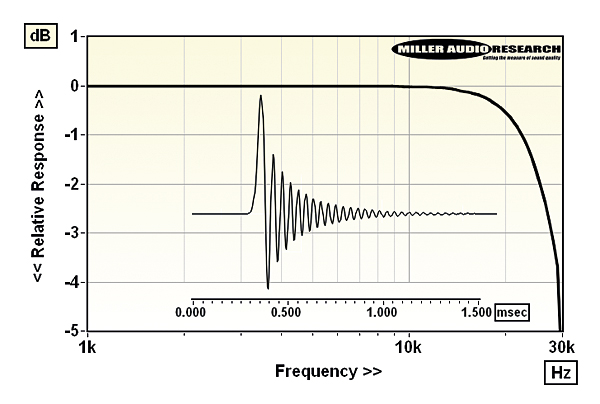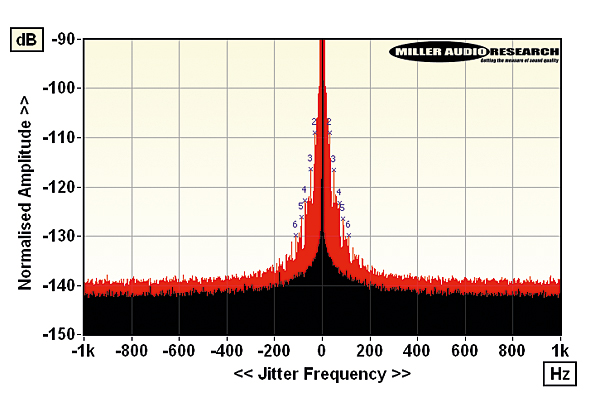Naim Audio NSS 333/NAC 332/NAP 350 DAC/Pre/Power System Lab Report
Naim NSS 333
The NSS 333's response and time domain behaviour is entirely determined by Naim's custom 16x upsampling digital filter. This brickwall IIR filter is executed on a SHARC DSP and is combined with two series-connected 3rd-order analogue filters (6th-order roll-off) at the output. Specifically, Naim's minimum phase digital filter avoids acausal pre-ringing, but does exhibit extended post-ringing [see Graph 1, below]. The partnering Burr-Brown PCM1791A, a legacy 'Advanced Segment' DAC, operates up to 192kHz/24-bit and DSD64, but its response here does not exceed 30kHz with either 96kHz or 192kHz media. Instead, Naim's digital filter cuts in earlier, delivering a ~60th-order roll-off at –3dB/27kHz. With CD/48kHz media the response reaches –0.55dB/20kHz, the filter, gentle at this point, offering a 43.5dB stopband rejection (26kHz re. 22kHz at 48kHz sampling).
Maximum output is 2.1V from a 22ohm balanced source impedance (increasing to 286ohm/20Hz – see Lab Report p47) where the NSS 333 also furnishes a 106.3dB A-wtd S/N ratio and fine low-level linearity of ±0.2dB over the top 100dB of the streamer/DAC's dynamic range. Distortion is low at 0.0007% midband (falling to 0.0002% over the top 30dB of its range) and while there's some peak level 'stress' indicated at 20kHz/0dBFs where THD reaches 0.016%, it soon falls back to a minimum of 0.0008%. Moreover, HF distortion over 10kHz is mainly 2nd harmonic in nature as any (digital) 3rd-order products are attenuated by the 30kHz filter. Finally while Naim's digital RAM buffer has worked effectively on earlier products [HFN Apr '19], in this instance there was a marked difference in low-rate jitter between USB (10psec) and S/PDIF (3345psec) inputs [see Graph 2]. Naim will be issuing a firmware update to remedy this. PM


| Max. output level / Impedance (bal XLR) | 2.11Vrms / 286-22ohm |
| A-wtd S/N ratio | 106.3dB |
| Distortion (1kHz, 0dBFs/–30dBFs) | 0.0007% / 0.0002% |
| Distortion & Noise (20kHz, 0dBFs/–30dBFs) | 0.016% / 0.00075% |
| Freq. resp. (20Hz-20kHz/30kHz) | +0.0 to –0.55dB/–7.0dB |
| Digital jitter (S/PDIF / USB / Network | 3345psec / 9psec / 10psec |
| Resolution (re. –100dBFs / –110dBFs) | ±0.2dB / ±0.5dB |
| Power consumption | 17W (16W standby) |
| Dimensions (WHD) / Weight | 432x92x318mm / 11kg |
Naim NAC 332
With no RIAA phono stage or integrated DAC on board – Naim offers the NVC TT and NSS 333, respectively, to fulfil these roles – the NAC 332 remains a fully analogue, balanced line preamplifier with a dedicated headphone amp. Maximum gain is a generous +15.5dB, or x6 (balanced in/out) which yields a total system gain of +44.1dB with the NAP 350 in tow. This is very high when used with a modern, balanced line-level source like the NSS 333 so the NAC 332 is best configured with an input trim of –10dB to optimise the 'usable' range of its volume control. The NAC 332's maximum 9.6V output is more than sufficient to drive the NAP 350, with its 1.4V input sensitivity, into clipping. Nevertheless, even at high gain the NAC 332's defining parameters – noise, distortion, response, etc – fall within, or are comparable to, the 'envelope' of the partnering NAP 350.
Specifically, the NAC 332's A-wtd S/N clocks-in at a very respectable 95.1dB (re. 0dBV) while the residual noise is a low –93.3dBV (22µV). The line frequency response is flat to –0.03dB/20Hz and –0.60dB/20kHz but rolls away to –15.9dB/100kHz and, more steeply, at low sub-bass frequencies to –3dB/2Hz [black trace, Graph 1]. The latter is also reflected in the (AC-coupled) output impedance trend which increases from a moderate 22ohm (200Hz-100kHz) to 230ohm/25Hz [red trace, Graph 1]. Distortion, as anticipated, is very low at 0.00035-0.0019% (20Hz-20kHz, re. 0dBV), rising fractionally to just 0.0039%/40kHz [see Graph 2]. Channel balance is a very fine 0.02dB but there's a hint of capacitive-coupling suggested in the stereo separation, falling from 90dB/1kHz to 63dB/20kHz. PM


| Maximum output (<1% THD, 47kohm) | 9.6Vrms (Balanced) |
| Maximum input level (<1% THD) | 9.8Vrms (Balanced) |
| Output impedance (20Hz–20kHz) | 230-22ohm (Balanced) |
| Freq. response (20Hz–20kHz/100kHz) | –0.03dB to –0.60dB / –15.9dB |
| Input sensitivity (re. 0dBV) | 170mV (Balanced) |
| A-wtd S/N ratio (re. 0dBV) | 95.1dB |
| Distortion (20Hz-20kHz re. 0dBV) | 0.00035-0.0019% |
| Power consumption | 19W (1W standby) |
| Dimensions (WHD) / Weight (total) | 432x92x318mm / 11kg |
Naim NAP 350
Naim's high-end Statement-inspired output devices – the N-type (NA009N) and P-type (NA009P) power transistors – are used both in the NAP 350's audio power amp and power supply, as they are in the older NAP 500 DR [HFN May '16]. Naim's fully discrete PSU regulation is also retained – it's effectively a low-noise DC amplifier where the DC reference (a vanishingly quiet sub-surface zener diode) is bootstrapped to the output of the PSU, reducing both the residual noise and the source impedance of the supply. The result is a very tightly regulated PSU that supports a full 192W/8ohm and 361W/4ohm but offers no dynamic headroom – the NAP 350's power output is all but identical under both continuous and transient conditions yielding 189W, 349W, 599W and 948W into 8, 4, 2 and 1ohm loads [re. 1kHz/10msec at <1% THD; see Graph 1 below].
In this, and many other respects, the NAP 350 mirrors the NPA 500 DR although the more affordable newcomer is markedly more powerful (192W vs. 144W) and more load-tolerant (30.8A vs. 18.7A into 1ohm). Again, the low-noise DR supply is beneficially reflected in the wide 92.2dB A-wtd S/N ratio of the amp (re. 0dBW) just as Naim's output series resistor holds the amp's source impedance at a moderate 0.20-0.26ohm. So while the default 8ohm response is –0.2dB/20kHz to –3.2dB/100kHz (almost identical to the NAP 500 DR) some slight variation may still occur into variable speaker load impedances. Distortion is a steady 0.004-0.01% through the midrange over the rated 175W bandwidth and increases gently at high frequencies to 0.025%/20kHz at 1W and 0.06%/20kHz at 100W, but is lowest at 10W, falling to 0.01%/20kHz [see Graph 2]. PM


| Power output (<1% THD, 8/4ohm) | 192W / 361W |
| Dynamic power (<1% THD, 8/4/2/1ohm) | 189W / 349W / 599W / 948W |
| Output imp. (20Hz–20kHz/100kHz) | 0.204-0.210ohm / 0.256ohm |
| Freq. resp. (20Hz–20kHz/100kHz) | +0.0dB to –0.23dB/–3.2dB |
| Input sensitivity (for 0dBW/175W) | 107mV / 1412mV |
| A-wtd S/N ratio (re. 0dBW/175W) | 92.2dB / 114.6dB |
| Distortion (20Hz-20kHz, 10W/8ohm) | 0.0049-0.012% |
| Power consumption (Idle/Rated o/p) | 18W / 353W (1W standby) |
| Dimensions (WHD) / Weight (total) | 432x91.5x318mm / 16.5kg |
| Prices | £7933 (pre and streamer), £12,340 (monoblock pair) |




















































